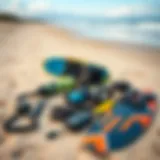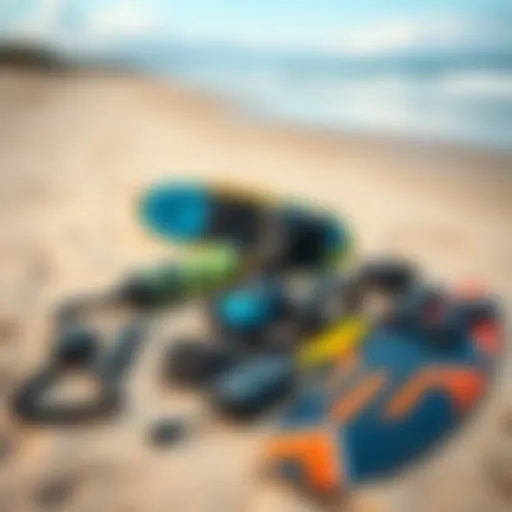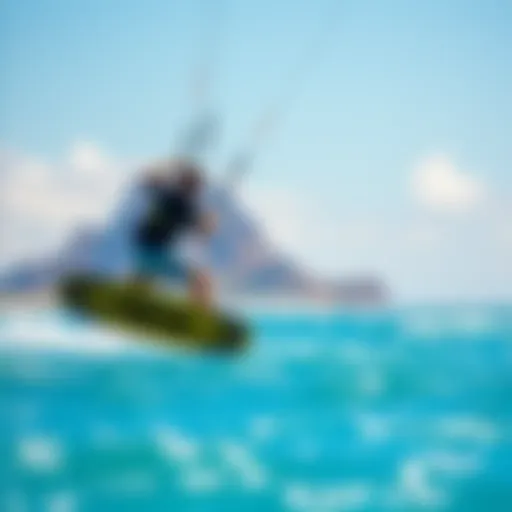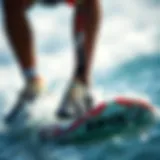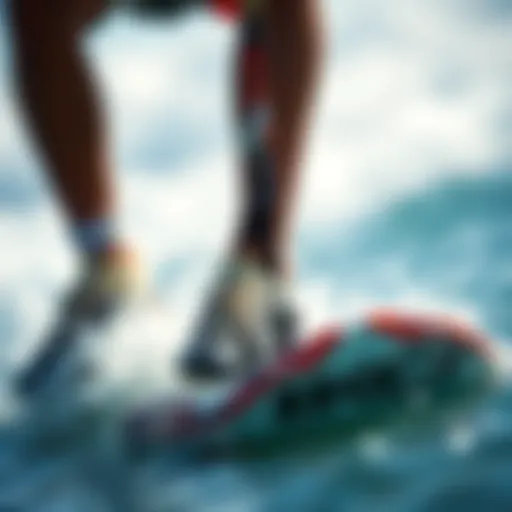Myrtle Beach Kite Surfing: A Complete Enthusiast's Guide
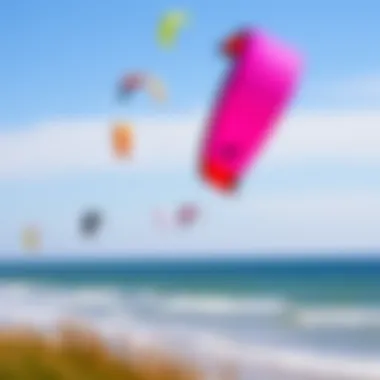

Intro
Kite surfing has taken off as a thrilling hobby for many beachgoers, and Myrtle Beach is no exception. Nestled on the South Carolina coast, this location offers a perfect blend of winds, waves, and natural beauty that draws both amateurs and seasoned kiteboarders alike. Whether you're just dipping your toes in the water or looking to refine your skills, understanding the nuances of kite surfing here can greatly enhance your experience.
Myrtle Beach stands out not only for its scenic views but also for its unique conditions that favor a variety of skill levels. As kite surf enthusiasts gather at sandy spots, they form a vibrant community bound by a shared love for the sport. However, understanding where to set up, what gear is necessary, and the techniques involved is critical for a safe and enjoyable experience. In this guide, we’ll explore the most important elements that will help you navigate the local kite surfing scene, ensuring that you make the most of your time on the water. From insights on the latest gear to techniques for improving your skills, we cover it all with an eye towards both safety and environmental considerations.
Prolusion to Myrtle Beach Kite Surfing
Kite surfing, a sport that marries the thrill of surfing with the power of the wind, has turned heads along the stunning coastline of Myrtle Beach. This introduction sets the stage for understanding not just the mechanics of the sport but also what makes this location particularly special.
The key benefit of kite surfing at Myrtle Beach lies in its unique combination of favorable wind conditions, scenic landscapes, and a supportive community. Whether you're a novice longing to catch your first wave or an expert looking to land complex tricks, Myrtle Beach caters to all. It provides an opportunity to experience the blend of exhilaration that comes with harnessing the wind while being surrounded by picturesque views.
Overview of Kite Surfing
Kite surfing is a water sport that uses a large controllable kite to propel oneself across the water. When the wind catches the kite, it exerts a force that allows the rider to glide over the waves, making maneuvers that can be both exhilarating and graceful. Riders stand on a board, similar to a surfboard, but with adaptations to handle the rigors of being pulled by the kite.
The equipment involved may seem overwhelming at first, but breaking it down into essential components—such as the kite, the board, and the harness—makes it easier to grasp. Learning the fundamentals of kite surfing can be akin to learning how to ride a bicycle; once you get the hang of it, a whole new world opens up.
Why Myrtle Beach is a Popular Destination
Myrtle Beach attracts kite surfers for various compelling reasons. For starters, the region boasts a generally mild climate, which means you could find yourself riding the waves almost all year round. Visitors often praise the consistency of the winds, which generally blow from the northeast and can reach a range of 10 to 20 knots. This reliability makes for ideal conditions for both newcomers learning the ropes and seasoned kiteboarders pushing their limits.
Moreover, the local infrastructure supports the sport well, with many accessible beaches and designated kiteboarding areas. Those thinking about logistics will appreciate that multiple rental shops offer top-notch gear, so anyone can get started without having to invest heavily upfront.
Additionally, the vibrant community of kite surfers here fosters a welcoming atmosphere. From local meetups to organized competitions, there’s always something happening that connects fellow riders. The rhythm of the local lifestyle embraces the sport, making it feel inclusive and exciting.
"Kite surfing is not just a sport; it’s a way of life that connects you with nature and the local community."
In essence, Myrtle Beach stands out as a haven for kite surfing, balancing natural beauty with an environment that promotes skill development and camaraderie among enthusiasts. This section lays the groundwork for diving deeper into what gear to choose, local conditions to anticipate, and the techniques needed for both success and safety while kite surfing at this coastal paradise.
Understanding Kite Surfing Gear
When it comes to kite surfing, choosing the right gear can make or break your experience on the water. With the right setup, you'll not only improve your skills but also enhance your enjoyment. In this section, we will dissect the core components necessary for kite surfing and provide insights on how to select the best gear tailored to your level of expertise.
Essential Equipment for Beginners
For those just dipping their toes into kite surfing, having the right basics is paramount. The fundamental equipment that novices should focus on includes the following:
- Kite: The heart of your kiteboarding setup. Beginners should look for a trainer kite, usually small and easy to control. As confidence builds, transitioning to a larger kite designed for more power is the next step.
- Board: A shorter, lighter board helps beginners learn quickly. You might want to try a twin-tip board, which allows for riding in both directions.
- Control Bar and Lines: Ensure that you purchase a control bar that allows for easy manipulation of the kite. The lines should be strong yet lightweight.
- Safety Equipment: A harness, helmet, and impact vest are essentials you shouldn't overlook. Many beginners learn through trial and error, and these items can protect against mishaps.
- Wetsuit: Depending on the season, a wetsuit may be necessary for warmth and buoyancy. Choose the thickness based on local conditions.
Getting these items right will set the stage for a fruitful learning experience.
Advanced Gear Considerations
Once you've got the basics down and feel ready to take your kiteboarding to the next level, it’s time to consider more advanced equipment that can enhance performance.
- Kite Varieties: Advanced kite surfers should explore different types of kites, such as cross-over kites, which are versatile across multiple conditions, or wave kites designed for enhanced performance in ocean swells.
- Board Types: Consider specialized boards depending on your riding style. Freestyle boards, for instance, are designed for jumping, while directional boards are ideal for surfing waves.
- Customization: As you begin to refine your style, customizing your equipment—like adjusting the fin setup on your board—helps to stabilize your ride and allows for personal preference.
- Advanced Safety Gear: Upgrading to safety gear that is more durable and robust can greatly reduce the risk of injury.
- Technology and Gadgets: Some kite surfers enjoy integrating technology into their sessions. GPS devices can help track performance metrics, while action cameras can document your progress.
Investing in quality equipment at this stage can dramatically elevate your riding experience and capabilities.
Local Retailers and Rentals
Finally, knowing where to get your kite surfing gear is essential, particularly if you’re traveling to Myrtle Beach. Here are some local retailers and rental options worth considering:


- Local Shops: Shops like Ocean Air Sports and Kiteboarding Myrtle Beach not only offer a variety of kite surfing gear but also facilitate a community feel, allowing new riders to ask questions and seek advice.
- Equipment Rentals: If you're not ready to buy, rental options are plentiful. Places like Kite & Surf provide equipment rentals and typically include insurance for peace of mind.
- Guided Lessons: Many local shops offer lessons along with gear rentals. A good instructor can help you choose appropriate equipment and make the learning process less daunting.
With proper gear and local know-how at your fingertips, you’ll be well-prepared to hit the waves and hone your kite surfing skills.
Climate and Wind Conditions at Myrtle Beach
When it comes to kite surfing, the right climate and wind conditions can mean the difference between a smooth ride and a challenging day on the water. For enthusiasts heading to Myrtle Beach, understanding these factors is crucial for enhancing their experience. The combination of warm temperatures, consistent breezes, and an extensive shoreline provides a suitable playground for novices and seasoned kiteboarders alike.
Myrtle Beach enjoys a humid subtropical climate. Winters are mild and dry, perfect for those who want to escape colder regions, while summers can be hot and humid with occasional thunderstorms. This diversity allows kite surfers to find favorable conditions almost year-round if they know when and where to go.
"The wind is what carries the kite, and without it, you're just a swimmer!"
Knowing the local weather patterns assists in selecting the best times to hit the waves. Kite surfing thrives on reliable wind, allowing riders to focus on their skills and enjoy the sport without unnecessary hitches.
Ideal Seasons for Kite Surfing
The prime kite surfing season in Myrtle Beach spans from late spring into early fall. Generally, the months of May through September stand out as particularly beneficial. During these months, wind patterns are consistent, often providing steady winds ranging from 12 to 25 knots.
- Spring: As temperatures begin to rise in April, kite surfers can start exploiting the emerging winds. The spring breezes can be brisk and refreshing, giving newbies a chance to practice without overwhelming conditions.
- Summer: Peak season for kite surfing, especially June through August. Warm waters and consistent winds make for idyllic conditions. Crowds might increase, but the vibrancy of summer adds an extra layer of energy to the atmosphere of the beach.
- Fall: In September and October, kite surfing remains viable. Winds often continue to blow steadily, and the weather is usually still warm enough for prolonged sessions. Less crowded beaches in the fall also offer a peaceful environment for focused practice.
Understanding Wind Patterns
When kite surfing, knowing how to read wind patterns is as important as having the right gear. The coastal geography of Myrtle Beach contributes to unique wind behaviors that affect the experience of riders.
During the early mornings, the winds tend to be lighter, making it ideal for beginners who wish to get accustomed to their gear. Conversely, as the day heats up, thermals can kick in, generating stronger winds that may appeal more to experienced kiteboarders.
Key wind patterns to note include:
- Onshore Winds: Best for beginners as they guide surfers back towards the shore. This is common during summer months when the land heats up quicker than the ocean.
- Cross-Shore Winds: These provide great lateral movement but require more skill, as riders need to navigate safely away from shore without getting too far out.
- Offshore Winds: Not recommended for beginners due to the risk of being carried away from the safety of the beach.
Overall, by grasping these principles of wind patterns and considering seasonal variations, kite surfers can maximize their enjoyment and minimize challenges. A careful balance of awareness regarding climate and wind conditions ensures each ride is exhilarating rather than daunting.
Techniques for Success
The path to becoming an adept kite surfer at Myrtle Beach requires a solid understanding of different techniques. Mastery of these skills not only enhances your experience but also significantly influences safety and performance. Focusing on the progression from basic maneuvers to advanced tricks enables kiteboarders to navigate the water confidently, adapt to changing conditions, and truly enjoy this exhilarating sport. Here’s a detailed exploration of the techniques essential for success.
Basic Maneuvers for Beginners
For those just starting out, the first steps in kite surfing can feel overwhelming. However, breaking down the fundamental maneuvers can make learning manageable and, importantly, enjoyable.
- Launching and Landing the Kite: Perhaps the most crucial skill for beginners is knowing how to launch and land the kite safely. Positioning your kite at 12 o’clock during launch provides maximum control, while landing the kite directly downwind at around 45 degrees is safest.
- Edging: This technique involves angling the board to maintain speed and control. For beginners, practicing edging in flat water can build confidence. Lean back while shifting pressure on the heels or toes to control the direction.
- Riding Upwind: Striving to ride upwind is vital for any kiteboarder. Begin by maintaining tension in the lines, and position the kite properly to generate lift. This skill requires patience and practice but is key for longer rides.
- Body Positioning: A stable stance greatly influences balance. Keep your knees slightly bent and your body aligned over the board to ensure the best grip on the water while maintaining control.
Starting with these basic maneuvers allows newcomers to lay a solid foundation, preparing them for the next stage of skill development.
Progressing to Intermediate Skills
Once the basic maneuvers are second nature, kite surfers can transition to intermediate skills that expand the capabilities on the water. Understanding these techniques not only increases skill but also boosts confidence.
- Transitions: Practicing smooth transitions is essential. This involves shifting direction while maintaining speed. Begin by turning the kite gently towards the new direction and adjusting your body position accordingly.
- Jumps: Learning to jump can be a thrilling milestone for kiteboarders. Start by gaining sufficient speed, and then pull the kite sharply towards 12 o’clock. Timing the jump with kite movement is critical for safe landings.
- Riding Switch: This skill refers to the ability to ride with your non-dominant foot forward. It adds versatility and helps improve overall balance. Start practicing by alternating between feet as you gain proficiency in riding.
- Tack and Jibe: Tacking and jibing are valuable steering techniques. Tacking allows you to change direction without losing speed, while jibing involves turning downwind. Both boost maneuverability and enable kite surfers to navigate different scenarios smoothly.
Mastering these intermediate skills paves the way for more advanced techniques and greater enjoyment of kite surfing at Myrtle Beach.
Advanced Techniques and Tricks
For those who have the basics and intermediates down, the horizon opens to advanced techniques and tricks that not only showcase skill but also provide a sense of thrill.
- Aerial Tricks: Advanced kite surfers can attempt various aerial tricks, such as grabs and spins. The key to executing these movements lies in timing the jump with the kite’s lift while carefully controlling body positioning.
- Handle Passes: This technique involves passing the handle from one hand to another mid-air. It requires a high level of control and precision, and practicing on smaller jumps can help you master it.
- Backrolls and Frontrolls: These rotations add flair to your kite surfing style. Begin with enough height and keep your head tucked during the rotation for balance. Once comfortable, practicing these can lead to even more complex tricks.
- Surf Style Tricks: This technique emphasizes the use of the kite in surfing maneuvers. Techniques like the bottom turn and cutback require a blend of kite control and wave riding can significantly enhance your surf sessions.


As confidence grows within this advanced arena, kite surfers can simply enjoy the rush of performing tricks while pushing their limits.
"Kite surfing is not just about the joy of riding the waves; it’s about the thrill of constantly learning and mastering new techniques to elevate one’s skills."
With dedication and practice, every kite surfer can ascend through the ranks, from a beginner learning the ropes to an advanced kite surfer capable of performing tricks that leave a mark. Stay committed to refining your techniques, and Myrtle Beach will continue to offer exhilarating experiences.
Local Regulations and Safety Tips
When engaging in kite surfing at Myrtle Beach, it’s crucial to be aware of the local regulations and safety protocols. Understanding these elements not only ensures your safety but also protects the natural environment and maintains a harmonious relationship with other beachgoers. Like any sport, kite surfing has rules that, if followed, can enhance your experience and help avoid unnecessary issues. This section dives into the legal requirements and necessary safety protocols you should keep in mind.
Legal Requirements for Kite Surfing
First and foremost, it’s essential to familiarize yourself with the specific legal requirements for kite surfing in Myrtle Beach. Local laws can vary significantly, and being informed helps you avoid potential fines or penalties.
- Permits: Check if you need any surfing permits. Certain area might require a license for kiteboarding, especially if you’re planning to set up gear in public spaces.
- Insurance: While it may not be legally mandated, holding liability insurance is advisable. Some kite surfers prefer insurance that specifically covers accidents, injuries, or damages that may occur on the water.
- Local Signage: Pay attention to any signs detailing local rules or regulations. Specific areas may have designated kiteboarding zones or restrictions against kite surfing when beaches are crowded.
- Environmental Protection: Respect protected areas of the coastline, particularly where wildlife might be nesting or feeding. Fines can be hefty for trespassing or disturbing these locations.
Be informed; knowledge is power, especially when enjoying sports that involve dynamic environments like the ocean.
Safety Protocols to Follow
Navigating the waters with a kite can be exhilarating, but safety should always be the top priority. Here are some standard protocols that every kite surfer, from novices to seasoned pros, should adhere to:
- Always Wear a Life Jacket: This is a non-negotiable rule. A properly fitted life jacket ensures your safety if you find yourself in a tricky situation on the water.
- Check Your Gear: Before heading out, inspect your kite, harness, and lines. Make sure there are no tears or signs of wear. Regular maintenance can prevent failures that might put you in danger.
- Know the Water Conditions: Understanding tides, currents, and potential hazards like rocks or other watercraft is essential. Make a habit of checking local reports before setting out.
- Communicate with Others: Always signal to other kite surfers about your direction and intentions. It's good practice to have designated areas where you can launch and land, keeping communication clear.
- Practice Recovery Techniques: Knowing how to self-rescue can be a lifesaver. Familiarize yourself with proper techniques to manage a downed kite and return safely to shore.
- Follow Local Guidelines: Every beach may have its own unique safety measures. Pay attention to local lifeguards or authorities for instructions or advice.
By combining awareness of legal requirements with solid safety practices, you’re setting yourself up for a successful kite surfing experience in Myrtle Beach. These measures not only keep you safe but also honor the community and environment that hosts this thrilling sport.
Environmental Considerations
Understanding the environmental impact of kite surfing is crucial for both practitioners and those who cherish the natural beauty of Myrtle Beach. This section elucidates how kite surfing interacts with local ecosystems and the importance of adhering to responsible riding practices. Ultimately, striving for a balance between the joy of the sport and ecological preservation benefits all.
Impact of Kite Surfing on Local Ecosystems
Kite surfing, although exhilarating, carries potential repercussions on Myrtle Beach’s ecosystems. The vibrant coastal environments possess unique flora and fauna that can be sensitive to disturbances. Here are several key points concerning this impact:
- Habitat Disturbance: When kite surfers tread over delicate ecosystems such as sand dunes and marshlands, it can lead to habitat destruction. Plants that stabilize sand dunes may be trampled, leading to erosion and an unstable shore.
- Wildlife Interference: Birds nest along the shores and in marshy areas during certain seasons. Flying kites can cause stress to these nesting birds, potentially leading to abandonment of nests, which hinders population growth.
- Water Quality Issues: Excessive numbers of kite surfers in concentrated areas can result in litter and pollution, affecting water quality. Trash from gear and bottles can find its way into the ocean, posing a danger to marine life.
In the grand scheme, awareness and education surrounding these impacts can cultivate a more enriching experience for all. By understanding our role within the ecosystem, kite surfers can contribute positively rather than detract from the environment.
Responsible Riding Practices
To mitigate the adverse effects kite surfing may have on local ecosystems, adopting responsible riding practices is essential. Below are some practices that kite surfers should consider:
- Stay on Designated Areas: Limiting activities to designated kite surfing zones plays a large part in protecting sensitive areas. Always check local regulations to ensure compliance.
- Litter Control: Carry out what you bring. Ensure you dispose of trash properly and encourage fellow kite surfers to do the same. If you see litter, take a moment to pick it up; it can make a difference.
- Awareness of Wildlife: Pay attention to nesting times and habitats of local wildlife. If you see birds nesting, avoid those areas to allow them to thrive.
- Use Eco-Friendly Gear: Opt for kite surfing equipment made from sustainable materials when possible. Innovations in eco-friendly gear can significantly lessen environmental footprints.
- Participate in Community Clean-Ups: Engage in local beach clean-up events. It’s a great way to foster community spirit while nurturing the island’s environment.
"The greater the awareness, the greater the responsibility to protect the environment we all love."
By embedding these practices into the sport, kite surfers not only enjoy their time on the water but also ensure Myrtle Beach remains a thriving spot for years to come.
Community and Events
The community and events surrounding kite surfing at Myrtle Beach play a crucial role in the overall experience for enthusiasts. They foster connections among kiteboarders, providing a sense of belonging, and help newcomers integrate into this vibrant culture. The collaborative spirit found in these gatherings and clubs enriches the sport itself, making every outing not just a personal endeavor but a shared adventure.
The importance of understanding local community dynamics cannot be overstated. They offer invaluable support and knowledge sharing that can greatly influence one's progress and enjoyment in kite surfing. Whether you’re a novice learning the ropes or an experienced rider looking to refine advanced tricks, local clubs and events are often the gateways to learning and improvement. They provide an environment where passion for the sport flourishes and where safety, respect for the environment, and good riding habits are promoted.
Kiteboarding Clubs and Organizations


Kiteboarding clubs and organizations around Myrtle Beach are the backbone of this community. Clubs like the Cape Hatteras Kiteboarding Association not only organize events but also facilitate training sessions and workshops. This often attracts riders across skill levels, from those just starting their journey to seasoned experts looking to master more complex maneuvers.
Participating in such clubs presents numerous advantages:
- Networking: Connect with fellow kiteboarders who share similar interests and experiences.
- Learning Opportunities: Take advantage of organized lessons or peer-led training sessions to enhance your skills.
- Access to Resources: Clubs often partner with local shops for discounts on gear and equipment or offer rental services at reduced rates.
Enthusiasts can keep track of local happenings through various social media platforms, like Facebook groups or forums on Reddit such as r/Kiteboarding. These platforms are often buzzing with activity, featuring discussions about kite designs, safety tips, and local session planning.
Local Competitions and Festivals
Local competitions and festivals not only spotlight the exciting aspects of kite surfing but also strengthen the community ties. Events like the East Coast Kiteboarding Championship draw contenders from far and wide, turning the beach into a vibrant display of talent and spirited competition. Such gatherings typically feature various events, including freestyle, race, and even slackline competitions, allowing riders to showcase their exceptional skills.
In addition to competition, these festivals often have opportunities for fun activities and socializing. This includes:
- Demonstration Flights: Leading brands often showcase the latest gear.
- Workshops and Clinics: Direct involvement with professionals can lead to transformative learning experiences.
- Community Engagement: Events frequently include opportunities for giving back, such as beach cleanups or workshops on environmental responsibility.
The takeaway? Engaging in local events and communities is pivotal for personal growth and for fostering a responsible kite surfing culture. Riding isn’t just about the solo journey; it’s about enjoying the wind together with a community of like-minded people, sharing stories, experiences, and building memories that last a lifetime. As you plan your kite surfing excursions at Myrtle Beach, make sure to immerse yourself in this dynamic community—it can truly elevate your kiteboarding experience!
"In kite surfing, every moment on the water can spark friendships that last beyond the waves. Dive into community and make your ride unforgettable!"
For more information on local clubs and events, check out resources like kiteboarder.com or follow Myrtle Beach-specific social media pages.
Traveling to Myrtle Beach for Kite Surfing
When venturing to Myrtle Beach for kite surfing, it’s crucial to plan appropriately. This isn’t just about grabbing your board and heading to the beach. A strategic approach to traveling can greatly enhance the overall experience for any kiteboarding enthusiast. From finding the right place to stay to figuring out the best ways to get around, understanding these elements can lead to a smoother and more enjoyable trip.
Accommodations for Kiteboarders
Selecting the right accommodation can make or break a kite surf trip. Fortunately, Myrtle Beach boasts a range of options tailored specifically for kiteboarders. From beachfront hotels to specialized surf hostels, the choices cater to various budgets and preferences.
- Location is key: Look for places near popular kite surfing spots like the North Myrtle Beach. This minimizes travel time and allows you to take advantage of the best wind conditions at a moment’s notice.
- Amenities to consider: Many kiteboarders prioritize amenities like gear storage, washing stations for sandy equipment, and easy access to rental shops. Some hotels even offer package deals with local kite schools, which can be a major plus for both beginners and experienced surfers.
- Affordable options: For those who are watching their wallets, vacation rentals or budget motels often offer great proximity to the water without breaking the bank. Websites like AirBnB or Booking.com can be great places to scout out affordable digs that still cater to the needs of an active lifestyle.
Transportation Options
Once you’ve sorted accommodations, figuring out how to get around Myrtle Beach is the next step. This area is fairly accessible, and travelers have a variety of transport options that suit different preferences:
- Rental Cars: For those looking to explore the coastline, renting a car provides flexibility. It allows kiteboarders to venture to less crowded beaches or find ideal kite surfing spots that aren’t within walking distance.
- Bikes: If you're feeling adventurous, consider renting a bike. The beach has numerous paths that are perfect for a scenic ride. Plus, it’s an eco-friendly way to get around.
- Public Transport: Myrtle Beach has a public bus service known as the Coast RTA, which connects key areas around the city. It might not be the quickest option but can be a budget-friendly way to navigate around different kite surfing spots.
- Ridesharing: Services like Uber or Lyft are also available and can be handy after a long day on the water. They save the hassle of parking and allow for a relaxed return to your accommodation.
"When you're traveling to kite surf, the right accommodations and transportation can transform your experience from ordinary to extraordinary."
Planning ahead ensures you won’t miss out on the thrill of catching waves and cruising through the air. Taking into account various options available for both accommodations and transportation will make your kite surfing experience at Myrtle Beach all the more memorable.
End
Kite surfing at Myrtle Beach offers a captivating blend of thrilling experiences and the serenity of nature, making it a hotspot for both newcomers and seasoned kiteboarders. Understanding the essentials of this sport is pivotal—not only for enjoying the ocean breeze but also for ensuring safety, respect for the environment, and fostering a sense of community among practitioners. In this article, we've traversed various aspects that elevate the experience of kite surfing, touching on gear, techniques, and local conditions.
Summarizing the Experience
The sun-drenched beaches of Myrtle Beach present an unparalleled setting for kite surfing, attracting enthusiasts from far and wide. The core essence of this guide highlights key components such as:
- Gear: Selection of appropriate equipment is fundamental. Beginners need to grasp the basics, while more advanced surfers should consider technical advancements and personal preferences.
- Local Conditions: Knowledge of the local climate and wind patterns allows riders to maximize their time on the water. Understanding the ideal seasons and wind directions can turn a good day into a great one.
- Safety and Regulations: Abiding by local laws and adhering to safety protocols ensures that the sport remains enjoyable for everyone.
Ultimately, kite surfing at Myrtle Beach is not just about the adrenaline rush; it’s more about connection—connecting with the ocean, with fellow kite surfers, and with the environment that surrounds this activity.
Encouraging Responsible Kite Surfing
A responsible kite surfing practice hinges on respect—for nature, fellow surfers, and the local community. It’s crucial to leave only waves behind and preserve the beautiful landscape that draws so many kiteboarders every year. Here are some practices to keep in mind:
- Clean Up After Yourself: Whether it's picking up discarded kite lines or ensuring that your impact on the beach is minimal, every little effort counts.
- Respect Wildlife: Myrtle Beach boasts rich biodiversity. Keep a safe distance from nesting areas and avoid disturbing wildlife.
- Follow Local Guidelines: Always be informed about the local regulations designed to protect both surfers and marine life. Local authorities and community groups are there to help.
- Share the Space: Kite surfing spots can get busy, especially during peak season. Be polite, communicate with others on the water, and be aware of your surroundings to ensure everyone's safety.
By embracing a mindset of responsibility and respect, kite surfers can enhance their own experiences while also preserving the beach and waves for generations to come. As we wrap up this extensive guide, it is crucial to take these lessons to heart, ensuring that kite surfing becomes not just a sport but a unified and sustainable community effort.






